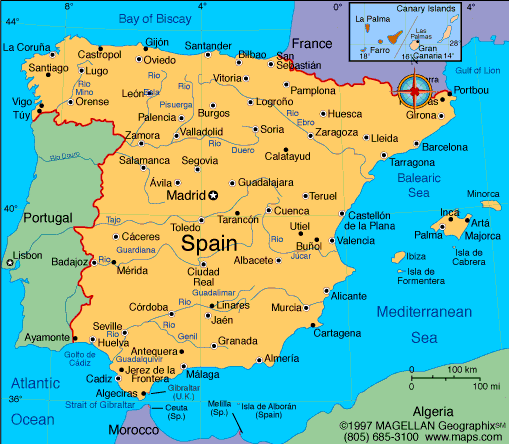Spain Map: Regions, Geography, Facts & Figures
The Infoplease map of Spain provides a glimpse into the country’s geography, climate, history, and attractions. Spain is located on the Iberian Peninsula in Western Europe and shares borders with Portugal, France, Andorra, and Morocco.
The official name of Spain is the Kingdom of Spain, and its capital city is Madrid. Spanish is the official language spoken in Spain, and the country has a population of approximately 47 million people. Spain's main industries include tourism, agriculture, manufacturing, and services.
If you want to discover more in-depth information on Spain as a country, check out our Spain Profile!
Test your country knowledge with our Spanish geography quiz, How Well Do You Know Barcelona?

Spain Facts: History
Spain's history dates back to prehistoric times and has been shaped by many different cultures, including the Romans, Moors, and Christians. Spain was a major colonial power in the 16th and 17th centuries, with territories in the Americas, Africa, and Asia.
Spain Facts: Geography
Spain's diverse landscape also includes arid deserts, lush forests, and rugged coastline. Spain's main geographic features include the Pyrenees Mountains, the Cantabrian Mountains, the Tagus River, the Bay of Biscay, the Atlantic Ocean, and the Mediterranean Sea.
Some of its major cities include Madrid, Barcelona, Valencia, Seville, Malaga, Zaragoza, Bilbao, Murcia, Palma, and Las Palmas de Gran Canaria. Spain’s two main island groups are the Canary Islands and Balearic Islands.
Spain is divided into 17 autonomous communities, including Andalusia, Aragon, Asturias, Basque Country, Cantabria, Castile-La Mancha, Castile and Leon, Catalonia, Extremadura, Galicia, La Rioja, Madrid, Murcia, Navarre, and Valencia.
Spain Facts: Tourist Attractions
Barcelona is famous for its architecture, beaches, and nightlife, while Madrid is home to world-class museums and galleries, including the Prado and Reina Sofia.
Seville is known for its historic architecture, including the Alcazar and the Cathedral of Seville, and Granada is home to the famous Alhambra palace and fortress.
Valencia is famous for its futuristic City of Arts and Sciences complex, while the Canary Islands and Balearic Islands are popular tourist destinations featuring beaches, nightlife, and outdoor activities.

People Also Search For...
Other online explorers of this country also commonly ask the following questions.
What Are the Neighboring Countries of Spain?
Spain shares borders with four neighboring countries: Portugal, France, Andorra, and Morocco. Portugal is to the west of Spain, France is to the northeast, Andorra is located in the Pyrenees mountains between Spain and France, and Morocco is across the Strait of Gibraltar to the south.
What Are the Main Geographic Features of Spain?
The map of Spain's main geographic features include the Pyrenees Mountains, the Cantabrian Mountains, the Tagus River, the Bay of Biscay, the Atlantic Ocean, and the Mediterranean Sea.
What Is the Climate of Spain Like?
Spain has a Mediterranean climate with hot, dry summers and mild, rainy winters. Cooler temperatures can be found in mountainous regions.
|
|








